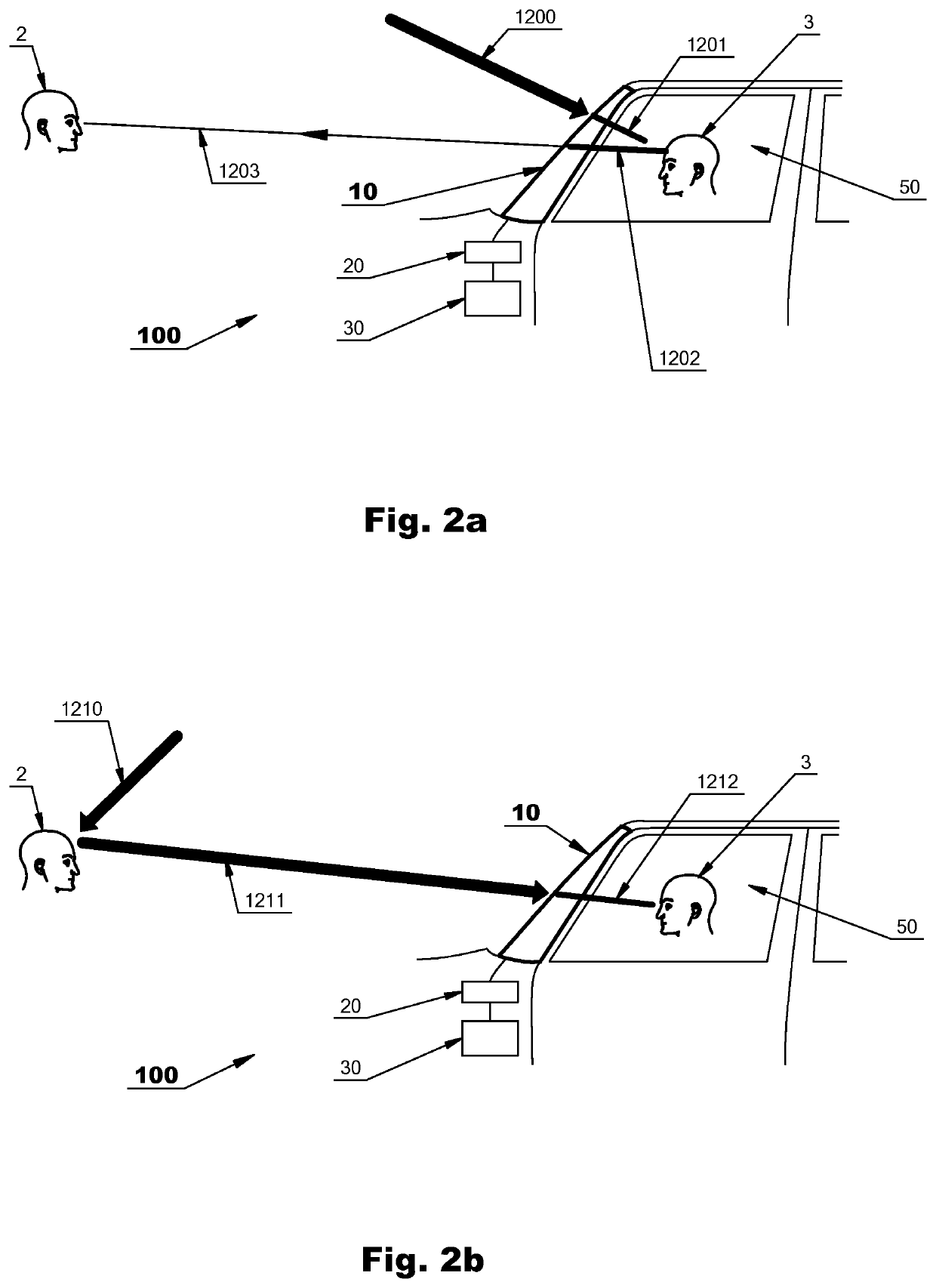Autonomous vehicle that minimizes human reactions
a technology of autonomous vehicles and human reactions, applied in the field of vehicles, can solve the problems of dangerous evasion actions, undesired and possibly dangerous reactions, and the driver may alter his/her driving line, so as to reduce light transmittance, obstruct visual access, and maximize visible light transmittance
- Summary
- Abstract
- Description
- Claims
- Application Information
AI Technical Summary
Benefits of technology
Problems solved by technology
Method used
Image
Examples
embodiment 100
[0070]FIG. 1b shows the first light state of embodiment 100 from the perspective of driver 1. Daylight 1110 provides illuminance on the face of viewer 2. Luminance is visible in the direction of driver 1 as indicated by light ray 1111. Windshield 10 transmits this as ray 1112 and viewer 2 is highly visible to driver 1. The luminance of surfaces outside the vehicle and viewed through windshield 10 in daylight have a similar brightness level to conventional vehicles.
[0071]FIGS. 2a and 2b show the autonomous vehicle 100 with its windshield 10 in the second light state. The vehicle control system 30 has engaged autonomous-driving-mode. The second light state can be selected by the vehicle control system 30 when autonomous-driving-mode is engaged or when not in driver-mode. In FIG. 2a daylight 1200 provides significant illuminance on the outer surface of windshield 10. In the second light state windshield 10 transmits about 35% of visible light or less (normal to its surface) as indicate...
embodiment 10
[0078]FIGS. 3a and 3b show the third light state of a windshield embodiment 10 from the perspective of someone outside a vehicle and a vehicle's occupant respectively. The vehicle control system 30 of autonomous vehicle 100 has engaged autonomous-driving-mode. The third light state can be selected by the vehicle control system 30 when autonomous-driving-mode is engaged, and its regular visible light transmittance is lower than in the second state and in some embodiments has a visible light transmittance of 10% or less.
[0079]Situations in which the third light state is desirable include emergency situations or situations likely to alarm a vehicle's occupants. When an emergency situation is detected by the vehicle (or remotely detected and communicated to the vehicle) visual access to the outside environment is momentarily reduced by the vehicle's control system to minimize fear or alarm felt by occupants as a collision is avoided. Similarly, in an otherwise safe manoeuvre that might ...
embodiment 500
[0101]In the vehicle embodiment 500 shown in FIG. 5 (in plan view) the vehicle control system 30 operates multiple embedded switchable light modulators to provide control of visual access in autonomous-driving-mode, not just through the windshield 10 but also through the front side windows 11, the rear side windows 12, the rear window 13, and openings 14 in the roof. The vehicle control system 30 communicates with subsystems over a CAN network 45. Subsystems shown in FIG. 5 include one or more switchable light modular controllers 20, associated light sensors and cameras 25, in-vehicle-infotainment (IVI) system 35, telematics 40 (including autonomous driving sensors, GPS, and V2X), security and alarm subsystem 55, seat belt monitoring subsystem 60, and eye tracking subsystem 65. Any of the subsystems mentioned in this document can also be systems or electronic control units (ECUs) and can exchange data with the vehicle control system and / or with each other.
[0102]The infotainment syst...
PUM
| Property | Measurement | Unit |
|---|---|---|
| Transmittivity | aaaaa | aaaaa |
| Transmittivity | aaaaa | aaaaa |
| Transparency | aaaaa | aaaaa |
Abstract
Description
Claims
Application Information
 Login to View More
Login to View More - R&D
- Intellectual Property
- Life Sciences
- Materials
- Tech Scout
- Unparalleled Data Quality
- Higher Quality Content
- 60% Fewer Hallucinations
Browse by: Latest US Patents, China's latest patents, Technical Efficacy Thesaurus, Application Domain, Technology Topic, Popular Technical Reports.
© 2025 PatSnap. All rights reserved.Legal|Privacy policy|Modern Slavery Act Transparency Statement|Sitemap|About US| Contact US: help@patsnap.com



